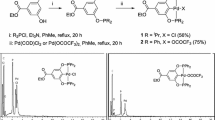Abstract
A new homogeneous catalyst system has been developed for the oxidation of olefins to carbonyls — ethylene to acetaldehyde and higher olefins to ketones. The catalyst system was first developed for the oxidation of ethylene to acetaldehyde in Wacker-type acetaldehyde plants. The aqueous catalyst solution has three key components. A palladium(II) catalyst oxidizes the olefin to the carbonyl, which is analogous to the Wacker system but with only a fraction of its palladium. Keggin phosphomolybdovanadates of the general formula PMo(12−x) V x O (3+x)−40 provide a dioxygen-reversible vanadium(V)/vanadium(IV) redox agent for palladium(O) reoxidation, which is analogous to the copper(II)/copper(I) chlorides in the Wacker system. Chloride at centimolar concentrations, lacking in earlier reported palladium and polyoxometalate catalyst systems, is essential to maintain stable palladium(II) catalyst activity. Kinetic characterization and reaction engineering provided ethylene and oxygen reaction rates comparable to those obtained with the Wacker catalyst. A new, efficient method of preparing aqueous phosphomolybdovanadate solutions was developed for laboratory and large-scale production. This paper describes the catalyst system and its reactions with emphasis on the polyoxometalate chemistry.
Similar content being viewed by others
References and Notes
International Applications published under the Patent Cooperation Treaty, Publication Numbers WO 91/13681, WO 91/13853, and WO 91/13853, and WO 91/13854, published 19 September, 1991.
J. H. Grate, D. R. Hamm, and S. Mahajan: inCatalysis of Organic Reactions; J. Kosak and T. Johnson (eds.), Marcel Dekker: (in press).
J. Smidt, W. Hafner, R. Jira, R. Sieber, J. Sedlmeier, and A. Sabel:Angew. Chem. Internat. Edit. 1, 80 (1962).
A. Aguilσ:Adv. Organomet. Chem. 5, 321 (1967).
R. Jira: inEthylene and Its Industrial Derivatives; S. A. Miller (ed.), Benn: London, pp. 639–659 (1969)
P. M. Henry:Palladium Catalyzed Oxidation of Hydrocarbons; D. Reidel: Dordrecht (1980).
K. I. Matveev, N. B. Shitova, Z. P. Pai, V. F. Odyakov, O. K. Akmalova, M. H. Ulrich, L. I. Kuznetsova, T. A. Basalaeva, A. V. Rumyantsev, L. P. Shadrin, and M. M. Dzalalova: United Kingdom Patent 1 508 331, published April 19, 1978.
K. I. Matveev, E. G. Zhizhina, N. B. Shitova, and L. I. Kuznetsova:Kinet. Katal. (Engl. Transl.) 18, 320 (1977).
K. I. Matveev:Kinet. Katal. (Engl. Trans.) 18, 716 (1977).
M. T. Pope:Heteropoly and Isopoly Oxometalates; Springer-Verlag, New York (1983).
L. Pettersson: in this volume.
L. Pettersson, I. Andersson, A. Söderlund, and J. H. Grate: (unpublished results).
Ref. [5a] Example 6.
L. I. Elding:Inorg. Chim. Acta 6, 647 (1972).
Author information
Authors and Affiliations
Rights and permissions
About this article
Cite this article
Grate, J.H., Hamm, D.R. & Mahajan, S. Palladium and phosphomolybdovanadate catalyzed olefin oxidation to carbonyls. Mol Eng 3, 205–229 (1993). https://doi.org/10.1007/BF00999634
Received:
Issue Date:
DOI: https://doi.org/10.1007/BF00999634




